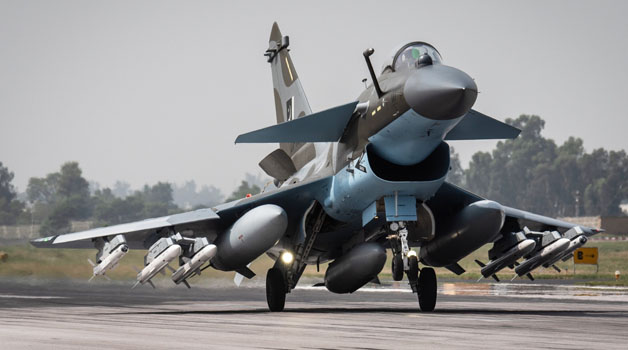In the annals of military transformation, rare are the moments when a confluence of
visionary insight, strategic foresight and relentless execution redefines the very fabric
of a nation’s strategic paradigm. Pakistan Air Force stands at a watershed moment
under the exemplary command of Chief of the Air Staff Air Chief Marshal Zaheer
Ahmed Baber Sidhu. His tenure marks not just an incremental progression but a
profound revolution in Pakistan’s aerial defence architecture. Emerging from this
transformation is not a mere conventional Air Force, but a sophisticated, integrated
Multi Domain powerhouse—a true Sentinel of the Skies—shaped through
unparalleled ingenuity, strategic acumen and steadfast conviction.
Air Chief Marshal Sidhu’s tenure is marked by a profound grasp of emerging combat
environments, extending well beyond traditional aerial warfare. Under his guidance,
Pakistan Air Force has redefined its strategic scope to integrate cutting-edge Cyber
Capabilities, Electronic Warfare and Space-Based technologies with enhanced
conventional air combat proficiency. This expanded operational vision has enabled
PAF to orchestrate a cohesive battle environment, where intelligence gathering,
reconnaissance and precision strike capabilities operate in unison through an
interconnected battlefield management system.
One of the most notable advancements in this period is the adoption of Multi Domain
operational strategy. This entails harmonizing resources across the physical sky,
cyberspace, electromagnetism and orbital platforms to create a unified situational
awareness landscape. The establishment of National Aerospace Science and
Technology Park serves as a testament to PAF’s commitment to nurturing
indigenous technological progress. By fostering local innovation and reducing
dependency on foreign systems, PAF is building a self-sufficient scientific and
defence ecosystem tailored to its unique strategic imperatives.
This doctrinal evolution has been rigorously tested during recent regional crises,
most notably the high-tension confrontation of May 2025. Facing an opponent with
superior numbers, PAF showcased the potency of integrated warfare by leveraging
sophisticated electronic attack systems that compromised adversary sensor arrays
and communication networks. The utilization of advanced J-10C fighters, armed with
PL-15 long-range precision missiles, empowered highly trained PAF pilots to
dominate engagements through tactical agility and out-of-range firepower. This
episode underscored the shift from reliance on numerical strength to the supremacy
of quality HR and technological advantage steered by a visionary leadership.
Central to this transformation is the Network-Centric approach that fuses Command,
Control, Communications, Computers, Intelligence, Surveillance and
Reconnaissance (C4ISR) capabilities into a robust, agile operational framework. By
enabling seamless data flow and rapid situational updates, this system empowers
commanders to anticipate and counter threats effectively. The May 2025 conflict
demonstrated the precision and coordination achievable through this integrated
command network, facilitating surgical responses that minimized risks and
maximized operational impact. This confirms a fundamental tenet of modern air
power: “Ownership of the electromagnetic spectrum and information dominance
decisively dictate conflict outcomes”.
In recognition of rapidly evolving warfare domains, PAF is expanding its operational
frontier beyond terrestrial confines. Cyber Operations have become a core focus,
directed at disrupting hostile digital infrastructures while safeguarding domestic
communication channels. Concurrently, space-based assets enhance Pakistan Air
Force’s reconnaissance and surveillance reach, offering strategic insights from the
high ground beyond Earth’s atmosphere. These capabilities prepare PAF for future
scenarios where control of outer space and cyberspace may rival traditional air
superiority in importance.
Underpinning these technical leaps is a substantial cultural renaissance within the
Air Force. Air Chief Marshal Sidhu’s leadership cultivates an ethos of rigorous
professionalism, discipline and relentless pursuit of operational excellence. This
cultural foundation is critical in sustaining the complex Multi Domain strategy,
ensuring personnel are equipped mentally and physically to navigate evolving
warfare challenges. This realignment from a conventional fighter-focused entity to an
integrated aerospace force forms a springboard for enduring adaptability and
strategic resilience.
The comprehensive modernization advocated by ACM Sidhu exemplifies a strategic
transition from mere defence toward proactive dominance. Pakistan Air Force now
functions as a sophisticated guardian across an expanded battle space—one that
seamlessly blends offensive and defensive operations across traditional skies and
new warfare frontiers. This extensive transformation enhances not only military
effectiveness but also enhances deterrence, securing national interests amid a
dynamic regional security matrix.
Pakistan Air Force’s evolution under ACM Sidhu’s leadership heralds a narrative of
transformation that challenges traditional paradigms of air power. It is now a versatile
institution adept in integrating diverse operational domains—Air, Cyber, Electronic,
AI and Space—to achieve comprehensive strategic advantage. This formidable
amalgamation positions PAF not only as a defender of sovereign airspace but as a
dynamic force shaping the future of warfare in the region.
As this journey unfolds, Pakistan Air Force stands ready to face emerging challenges
with unmatched resolve and sophistication. The legacy Air Chief Marshal Zaheer
Ahmed Baber Sidhu is crafting is one of enduring excellence and visionary
foresight—an unrivaled sentinel prepared to safeguard Pakistan’s sovereignty
through innovation, precision and an unshakeable commitment to operational
superiority.
This is no mere evolution but a decisive revolution in air power—a dawn
heralding a new chapter for PAF’s Guardians of the Skies.
Prev Post


Comments are closed, but trackbacks and pingbacks are open.